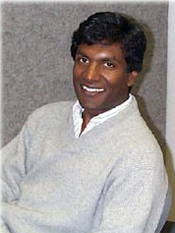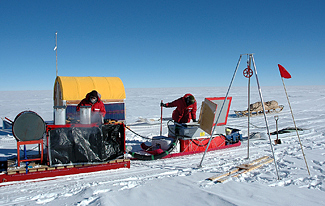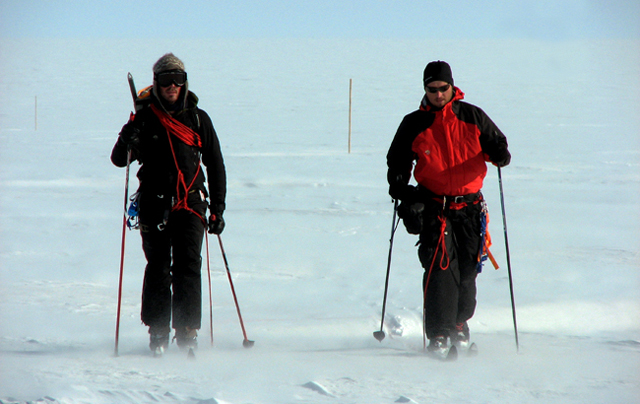Upon further reflectionPenn State glaciologist perpetuates seismic techniques to study ice in AntarcticaPosted November 12, 2010
Sridhar Anandakrishnan He was quite content with the path before him, already picking up his undergraduate and master’s degrees in electrical engineering at Columbia University The one required science course he took during that time wasn’t even in geology but astronomy. “I couldn’t tell a rock from a hole in the ground,” said Anandakrishnan, a slender man with a wide smile and easy laugh. 
Sridhar Anandakrishnan
A roommate in Madison nonchalantly dropped a flier on Anandakrishnan’s desk advertising for a job in the university’s geology department to build instrumentation for a project in Antarctica. The one caveat: He would have to travel to ice-covered continent to help install the equipment. It all sounded like a fun adventure, an interesting diversion. In 1985, he headed down to Antarctica to work on Ice Stream B, now called the Whillans Ice Stream, a large river of ice that drains the West Antarctic Ice Sheet into the Ross Ice Shelf. “It was a life-changing experience. It was such a beautiful, stark and important part of the world,” Anandakrishnan recalled of his first trip south to the continent that’s 99 percent covered by ice. After returning to the United States he resigned from the electrical engineering department and began remedial work in geology. He studied under the eminent glaciologist and geophysicist Charles Bentley Anandakrishnan turned down what probably would have been a lucrative career in electrical engineering to study the dynamics of ice when the field was still on the fringe of mainstream research. “It’s been a blast. I don’t regret it. Not for one second,” he said. Now a professor in the College of Earth and Mineral Sciences at Pennsylvania State University Reflection seismology uses seismic waves, or waves of energy generated from something like an earthquake or explosion, to learn about the properties of the Earth’s subsurface. Radar has been — and continues to be — a favored technique of glaciologists for learning about the properties of the polar ice sheets, glaciers and ice shelves. In West Antarctica, in particular, as the edges of the ice sheet melt from ocean warming, more ice is discharged into the ocean from the interior, causing sea level to inch up slowly. Critical to understanding how the ice flows toward the margins is figuring out the conditions that exist at the bedrock on which the ice rests and glides. Radar can provide details on ice thickness — even tell you if there is water below — but it doesn’t provide the sort of detail seismics can about the bedrock topography or the depth of a subglacial lake. That’s where Anandakrishnan and his students at Penn State come in. “People are realizing that reflection seismology is an incredibly important tool,” Anandakrishnan said. It’s still something of a niche field in Antarctica. That may explain why just about every significant glaciological project in West Antarctica involves Anandakrishnan and his team. 
Photo Credit: Sridhar Anandakrishnan
Researchers prepare a seismic survey over a subglacial lake at the South Pole.
For example, a multidisciplinary, multiyear project in West Antarctica called WISSARD The radar will help outline the margins of the lake, which was originally detected by satellite. For the three-dimensional depth of the lake, the scientist will use reflection seismology — hence the involvement by Penn State. “I’m not saying I’m very good at this. I’m just saying I’m the only one [in the USAP],” Anandakrishnan explained. “There’s nothing particularly special about doing it on ice except there’s a fund of experience that I’ve built up. The theory is the same everywhere.” The 47-year-old geoscientist said he expects the next generation of Antarctic seismologists will soon change what has been a lonely job. Former student Huw Horgan Another student, Paul Winberry at Central Washington University Winberry said he never had any intentions of becoming a glaciologist, but after working with Anandakrishnan in the field, the research and environment appealed to him. “There are always fun puzzles to figure out. Glaciers are an interesting phenomenon because we are still figuring out new things all the time,” Winberry said. Said Anandakrishnan, “Hopefully in the next five or 10 years there will be a bunch of people who can do the same thing [with reflection seismology]. But until now it’s been pretty thin.” NSF-funded research referenced in this story: Sridhar Anandakrishnan, Pennsylvania State University, Award Nos. 0838764, 0838763, 0944286 |



For USAP Participants |
For The Public |
For Researchers and EducatorsContact UsNational Science FoundationOffice of Polar Programs Geosciences Directorate 2415 Eisenhower Avenue, Suite W7100 Alexandria, VA 22314 Sign up for the NSF Office of Polar Programs newsletter and events. Feedback Form |


